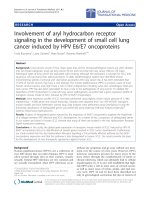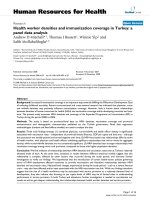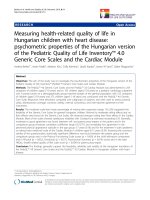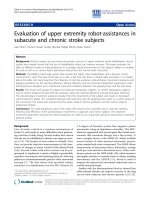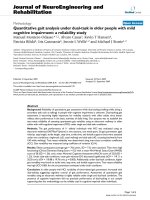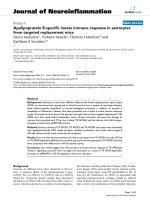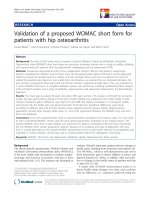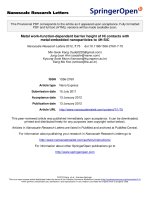Báo cáo toán học: " Lower striatal dopamine D2/3 receptor availability in obese compared with non-obese subjects" ppt
Bạn đang xem bản rút gọn của tài liệu. Xem và tải ngay bản đầy đủ của tài liệu tại đây (205.02 KB, 5 trang )
SHOR T COMMU N I C A TION Open Access
Lower striatal dopamine D
2/3
receptor availability
in obese compared with non-obese subjects
Barbara A de Weijer
1*†
, Elsmarieke van de Giessen
2†
, Thérèse A van Amelsvoort
3
, Erik Boot
3,4
, Breg Braak
5
,
Ignace M Janssen
6
, Arnold van de Laar
7
, Eric Fliers
1
, Mireille J Serlie
1
and Jan Booij
2
Abstract
Background: Obesity is a result of a relative excess in energy intake over energy expenditure. These processes are
controlled by genetic, environmental, psychological and biological factors. One of the factors involved in the
regulation of food intake and satiety is dopaminergic signalling. A small number of studies have reported that
striatal dopamine D
2
/D
3
receptor [D2/3R] availability is lower in morbidly obese subjects.
Methods: To confirm the role of D2/3R in obesity, we measured striatal D2/3R availability, using [
123
I]IBZM SPECT,
in 15 obese women and 15 non-obese controls.
Results: Striatal D2/3R availability was 23% (p = 0.028) lower in obese compared with non-obese women.
Conclusion: This study is an independent replication of the finding that severely obese subjects have lower striatal
D2/3R availability. Our findings invigo rate the evidence for lower striatal D2/3R availability in obesity and confirm
the role of the striatal dopaminergic reward system in obesity.
Keywords: obesity, dopamine receptor availability, [
123
I]IBZM SPECT
Background
Over the last decades, the average body mass index [BMI]
has increased worldwide. The prevalence of obesity (BMI
≥ 30 kg/m
2
) in the USA is now over 30% among adult s
[1]. This leads to a substantial increase in obesity-related
diseases and costs. Obesity is the result of an imbalance
between energy intak e and energy expenditure, and these
processes are normally controlled by genetic, environ-
mental, psychological and biological factors. Excessive
caloric intake of hi ghly palatable food can be regarded as
a compulsive-like feeding behaviour [2]. The mechanisms
underlying a disturbed appetite regulation and overeating
are poorly understood. However, a role for several neuro-
transmitters and hormones has been proposed (for a
review, see the study of Volkow et al. [3]).
There is a large body of evidence suggesting that over-
eating in obesity involves the neurotransmitter, dopamine.
Dopaminergic agonists induce anorexigenic effects, while
treatment with dopamine D
2
receptor [D2R] antagonists
(neuroleptics) induces obesity [4]. Moreover, a high preva-
lence of the TaqIA A1 allele for D2R, an allele known to
moderate food reward, has been found in obesity [5,6].
Finally, a role for dopamine and D2R has been established
in animal models of obesity [2]. Interestingly, two imaging
studies by the same group showed lower striatal dopamine
D
2
/D
3
receptor [D2/3R] availability in obese versus non-
obese subjects [7,8] although i n another study, a statisti-
cally significant lower availability in obese subjects was
only found by a voxel-based and not by region of interest
[ROI] analysis [9]. D2/3R imaging studies in obese humans
are scarce and inconclusive. Therefore, we evaluated
whether earlier findings of lower striatal D2/3R availability
in obesity can be replicated, in order to increase our
understanding on the potential role of dopamine in
obesity.
Materials and methods
Subjects
We included 1 5 obese (BMI ≥ 35 kg/m
2
)womenwho
were matched with 15 non-obese historical female con-
trols who participated in previous studies [10,11].
* Correspondence:
† Contributed equally
1
Department of Endocrinology and Metabolism, Academic Medical Center,
University of Amsterdam, Meibergdreef 9, Amsterdam, 1105 AZ, The
Netherlands
Full list of author information is available at the end of the article
de Weijer et al. EJNMMI Research 2011, 1:37
/>© 2011 de Weijer et al; licensee Springer. This is an Open Access article distributed under the terms of the Creative Commons
Attribution License ( which permits unrestricted use, distribution, and reproduction in
any medium, provided the original work is properly cited.
Exclusion c riteria for all subjects were (1) age below 18
year s, (2) current or past psychiatric disease, (3) current
or past exposure to do paminergic medication, (4) life-
time history o f alcohol/drug abuse, ( 5) concomitant or
past severe medical conditions, including diabetes melli-
tus, and (6) pregnancy.
The 15 obese subjects are participating in an ongoing
study on the early metabolic effects of Roux-en-Y gastric
bypass surgery. Here, we report on t he assessment of
striatal D2/3R availability before surgery. Each partici-
pant gave written informed consent. The protocol was
approved by the ethics committee of the Academic
Medical Center of Amsterdam.
Neuropsychological assessment
The obese subjects underwent neuropsychological
assessment by the team involved in the pre-assessment
for surgery and filled out the Beck Depression Inventory
version II [BDI-II] for assessment of depressive
symptoms.
Single photon emission computed tomography protocol
The subjects underwent a measurement of D2/3R binding
potential [BP
ND
] with single photon emission computed
tomography [SPECT] and the selective radiolabeled D2/3R
antagonist [
123
I]IBZM, using the sustained equilibrium/
constant infusion technique [12]. The applied protocol has
been described in detail previously [11]. SPECT data were
acquired for approximately 60 min, starting from 120 min
after the initiat ion of [
123
I]IBZM administration. SPECT
studies were performed using a 12-detector single-slice
brain-dedicated scanner (Neurofocus, Inc., Medfield, MA,
USA). The obese subjects were scanned in the morning
after an over night fast; the lean subjects were scanne d at
various moments of the day, and they were not fasting.
Image reconstruction and analysis
Attenuation correction of all images was performed as ear-
lier described [13]. SPECT data were reconstructed in 3-D
mode and analysed by the same investigator (BADW). For
quantification, a ROI analysis was performed, with fixed
ROIs for the striatum and occipital cortex, a s described
earlier [11]. Mean striatal and mean occipital bindings
were averaged from right and left ROIs. BP
ND
was calcu-
lated as the ratio of specific to non-specific binding ((Total
activity in striatum - Activity in occipital cortex)/Activity
occipital cortex).
Statistical analysis
BMI and age differences between groups were evaluated
with a non-paire d t test. Between-group comparisons in
striatal D2/3R BP
ND
were performed by analysis of covar-
iance [ANCOVA]. Since in-vivo D2/3R availability is
influenced by natural age ing [14], age was introduced as
a co-variate. Pearson’s correlation coefficients were calcu-
lated with two-tailed tests of significance to investigate
the relationship b etween striatal D2/3R BP
ND
and BMI.
A probability value of 0.05 which is two-tailed was
selected as significance level.
Results and discussion
Results
The mean BMI of the obese women was 46.8 ± 6.5 kg/m
2
versus 21.7 ± 2.1 kg/m
2
of the controls (Table 1; p <
0.0001). The obese women were older (37.8 ± 7 .0 years)
than the controls (28.0 ± 10.4 years; p =0.0057).TheBDI-
II r esults showed that none of the obese wom en had
severe depressive symptoms; only one felt in the category
of mild depression (score of 14), and the others had even
lower scores (scores 0 to 13).
The mean BP
ND
as a measure of striatal D2/3R availabil-
ity was 23% lower in th e obese group: 0.86 ± 0.22 for the
obese subjects and 1.12 ± 0.24 for the controls (Figure 1).
The ANCOVA revealed a significant main effect of group
on D2/3R availability in the striatum (F(1,29) = 5.39; p =
0.028). There was no significant effect of age on BP
ND
(F(1,29) = 0.69; p = 0.412). The BMI did not correlate sig-
nificantly with BP
ND
within the obese (r = - 0.392; p =
0.149) or the control group (r =-0.141;p = 0.617).
Discussion
This study replicates earlier findings that obese subjects
have lower striatal D2/3R availability than non-obese
subjects. The first two studi es to demonstrate this differ-
ence [7,8] were in a largely overlapping sample of obese
subjects with a mean BMI of 51 kg/m
2
. Haltia et al. [9]
replicated this finding only with a voxel-based analysis,
reporting a lower D2/3R availability in obese subjects in a
cluster partly cov ering the striatum. The major difference
with the first study was that the average BMI of the
obese group was lower (33 kg/m
2
). In the present s tud y,
we included obese women with a mean BMI of 47 kg/m
2
,
and we were able to replicate the finding with a ROI ana-
lysis. Thus, this suggests a decrease in striatal D2/3R
availability with increasing BMI.Thisisstrengthenedby
Table 1 Descriptive characteristics for obese and non-
obese control subjects
Descriptive characteristic Control
a
(n = 15) Obese
a
(n = 15)
BMI (kg/m
2
) 21.7 ± 2.1
(19.5 to 27.6)
46.8 ± 6.5
(38.7 to 61.3)
Age (years) 28.0 ± 10.4
(20 to 60)
37.8 ± 7.0
(26 to 49)
BDI-II score n.a. 5.6 ± 4.2
(0 to 14)
Striatal D2/3R availability (BP
ND
) 1.12 ± 0.24
(0.75 to 1.78)
0.86 ± 0.22
(0.5 to 1.28)
a
Data are shown as mean ± standard deviation (range); BDI-II, Beck
Depression Inventory version II.
de Weijer et al. EJNMMI Research 2011, 1:37
/>Page 2 of 5
the finding of a negative correlation between the BMI
and striatal D2/3R availability in the obese groups in the
previous studies [7,9].
It should be mentioned that one study, performed in
patients undergoing b ariatric surgery, found no signifi-
cant difference in striatal D2/3R availability between
obese subjects and historical controls [15]. However,
this study included only five women per group.
Although no statistical test was described, absolute D2/
3R availability shown in a graph was lower in the obese
than in control subjects. Thus, this study may not have
been able to detect a difference in D2/3R availability
between obese and controls due to insufficient sample
size.
Thepresentstudynorthepreviousonescansolvethe
question whether lower striatal D2/3R availability in obe-
sity is a causal factor in obesity or rather the result of the
obese condition. Carriers of the Taq1A allele in the gene
encoding for the D2/3R show a decrease d D2/3R expres-
sion [16] and have a higher susceptibility for obesity [5].
This would suggest that lower D2/3R expression levels are
a pre-existing condition that plays a role in the susceptibil-
ity. However, in rats, it has been shown that downregula-
tion of str iatal D2/3R can be induced by a cafeteria diet
and that this is associated with an increase in the suscept-
ibility for reward deficits and compulsive eating behaviour
[2]. The available studies on effects of weight loss after
bariatric surgery on D2/3R availability are scarce and show
conflicting results [15,17].
The in volvement of dopamine signalling in the regul a-
tion of food intake has been clearly established [3]. Its
major functions are related t o motivation and reward
and involvement in salience attribution to food. Food
intake induces a dopamine release in the striatum
thereby exerting its rewarding effect [18 ]. This is similar
to the effects of drug abuse [19], suggesting parallels
between obesity and drug addiction [3]. Part of the
aetiology of both conditions could be explained by a
hypodopaminergic mesolimbic system that leads to
increased motivation for food and drugs, respectively
[3]. In this context, it is of interest that the extent of
lower striatal D2/3R availability in obese subjects is
comparabl e to cocaine and alcohol abus ers [19]. Neve r-
theless, lower striatal D2/3R availability is probably only
one underlying mechanism in the disturbed balance
between energy intake and energy expenditure present
in obe se subjects. Peripheral metabolic signals, e.g. lep-
tin, ghreli n, insulin and hypothalamic neuropeptides are
able to interact with the striatal dopaminergic system as
well [3]. This complexity may explain the considerable
overlap in striatal D2/3R availability between obese and
non-obese women in the present study.
A limitation of this study is the difference in age
between the obese and control subjects. To correct this,
striatal D2/3R availability
control obese
0.0
0.5
1.0
1.5
2.0
BP
ND
Figure 1 Striatal D2/3R availability for obese and non-obese control subjects. Horizontal line indicates mean BP
ND
.
de Weijer et al. EJNMMI Research 2011, 1:37
/>Page 3 of 5
age was added as a co-variate to the statistical model.
Besides, it has previously been shown that age leads to a
decrease of 4.6% to 8.2% D2/3R availability per decade
[14,20]. As we found a 23% lower D2/3R availability in
our obese subjects, this difference is too large t o be
explained by age per se. Therefore, we believe that the
age difference does not significantly affect our results
and conclusions.
The two groups were not scanned under the same con-
ditions regarding fasting state. While the obese patients
were scanned after an overnight fast, the healthy controls
were not scanned in the fasted state. As previously men-
tioned, food intake induces a striatal dopamine release
[18], so this can transiently lead to increased dopamine
levels. However, even if t he fed state in the lean group
would have led to increased dopamine levels, this would
have resulted in a decrease of D2/3R availability and sub-
sequently in an underestimation of the presently observed
difference between the obese and lean groups.
Unlike previous studies on D2/3R availability in obesity
with mixed gender samples, t his study only included
women. Although this may affect the extrapolation of the
results to men, it increased the homogeneity of the sub-
jects and demonstrated that the lower D2/3R availability is
also detectable in females only.
Conclusion
In conclusion, this study is an independent replication of
the earlier finding that morbidly obese subjects have lower
striatal D2/3R availability detected by ROI analysis [7]. In
combination with the other available studies on this su b-
ject so far, this study invigorates the evidence for lower
striatal D2/3R availability in obesity and confirms the role
of the striatal dopaminergic reward system in obesity.
Author details
1
Department of Endocrinology and Metabolism, Academic Medical Center,
University of Amsterdam, Meibergdreef 9, Amsterdam, 1105 AZ, The
Netherlands
2
Department of Nuclear Medicine, Academic Medical Center,
University of Amsterdam, Meibergdreef 9, Amsterdam, 1105 AZ, The
Netherlands
3
Department of Psychiatry, Academic Medical Center, University
of Amsterdam, Meibergdreef 9, Amsterdam, 1105 AZ, The Netherlands
4
Ipse
de Bruggen, Centre for People with Intellectual Disability, Zwammerdam,
2470 AA, The Netherlands
5
Department of Gastroenterology, Academic
Medical Center, University of Amsterdam, Meibergdreef 9, Amsterdam, 1105
AZ, The Netherlands
6
Department of Surgery, Rijnstate Hospital, Wagnerlaan
55, Arnhem, 6815 AD, The Netherlands
7
Department of Surgery, Slotervaart
Hospital, Louwesweg 6, Amsterdam, 1066 EC, The Netherlands
Authors’ contributions
All authors contributed substantially to the scientific process leading to this
manuscript. Authors MJS, JB and EF contributed to the concept and design
of the study. BADW, IMJ and AVDL acquired data on the obese subjects, and
TAVA, EB and BB acquired data on the control subjects. Authors BADW and
EVDG analyzed the data. EVDG and JB drafted the manuscript, which was
revised by BADW, MJS and EF. TAVA, EB, BB, MJS and AVDL critically
contributed to the manuscript. All authors have read and approved the final
manuscript.
Competing interests
The authors declare that they have no competing interests.
Received: 10 October 2011 Accepted: 16 December 2011
Published: 16 December 2011
References
1. Finucane MM, Stevens GA, Cowan MJ, Danaei G, Lin JK, Paciorek CJ,
Singh GM, Gutierrez HR, Lu Y, Bahalim AN, Farzadfar F, Riley LM, Ezzati M:
National, regional, and global trends in body-mass index since 1980:
systematic analysis of health examination surveys and epidemiological
studies with 960 country-years and 9.1 million participants. Lancet 2011,
377:557-567.
2. Johnson PM, Kenny PJ: Dopamine D2 receptors in addiction-like reward
dysfunction and compulsive eating in obese rats. Nat Neurosci 2010,
13:635-641.
3. Volkow ND, Wang GJ, Baler RD: Reward, dopamine and the control of
food intake: implications for obesity. Trends Cogn Sci 2011, 15:37-46.
4. Leddy JJ, Epstein LH, Jaroni JL, Roemmich JN, Paluch RA, Goldfield GS,
Lerman C: Influence of methylphenidate on eating in obese men. Obes
Res 2004, 12:224-232.
5. Noble EP: D2 dopamine receptor gene in psychiatric and neurologic
disorders and its phenotypes. Am J Med Genet B Neuropsychiatr Genet
2003, 116B:103-125.
6. Stice E, Spoor S, Bohon C, Small DM: Relation between obesity and
blunted striatal response to food is moderated by TaqIA A1 allele.
Science 2008, 322:449-452.
7. Wang GJ, Volkow ND, Logan J, Pappas NR, Wong CT, Zhu W, Netusil N,
Fowler JS: Brain dopamine and obesity. Lancet 2001, 357:354-357.
8. Volkow ND, Wang GJ, Telang F, Fowler JS, Thanos PK, Logan J, Alexoff D,
Ding YS, Wong C, Ma Y, Pradhan K: Low dopamine striatal D2 receptors
are associated with prefrontal metabolism in obese subjects: possible
contributing factors. Neuroimage 2008, 42:1537-1543.
9. Haltia LT, Rinne JO, Merisaari H, Maguire RP, Savontaus E, Helin S, Någren K,
Kaasinen V: Effects of intravenous glucose on dopaminergic function in
the human brain in vivo. Synapse 2007, 61:748-756.
10. Boot E, Booij J, Hasler G, Zinkstok JR, de Haan L, Linszen DH, van
Amelsvoort TA: AMPT-induced monoamine depletion in humans:
evaluation of two alternative [123I]IBZM SPECT procedures. Eur J Nucl
Med Mol Imaging 2008, 35:1350-1356.
11. Boot E, Booij J, Zinkstok JR, de Haan L, Linszen DH, Baas F, van
Amelsvoort TA: Striatal D receptor binding in 22q11 deletion syndrome:
an [(1)(2)(3)I]IBZM SPECT study. J Psychopharmacol 2010, 24:1525-1531.
12. Booij J, Korn P, Linszen DH, Van Royen EA: Assessment of endogenous
dopamine release by methylphenidate challenge using iodine-123
iodobenzamide single-photon emission tomography. Eur J Nucl Med
1997, 24:674-677.
13. Booij J, Tissingh G, Boer GJ, Speelman JD, Stoof JC, Janssen AG, Wolters EC,
van Royen EA: [123I]FP-CIT SPECT shows a pronounced decline of striatal
dopamine transporter labelling in early and advanced Parkinson’s
disease. J Neurol Neurosurg Psychiatry 1997, 62:133-140.
14. Rinne JO, Hietala J, Ruotsalainen U, Säkö E, Laihinen A, Någren K,
Lehikoinen
P, Oikonen V, Syvälahti E: Decrease in human striatal
dopamine D2 receptor density with age: a PET study with [11C]
raclopride. J Cereb Blood Flow Metab 1993, 13:310-314.
15. Steele KE, Prokopowicz GP, Schweitzer MA, Magunsuon TH, Lidor AO,
Kuwabawa H, Kumar A, Brasic J, Wong DF: Alterations of central
dopamine receptors before and after gastric bypass surgery. Obes Surg
2010, 20:369-374.
16. Pohjalainen T, Rinne JO, Nagren K, Lehikoinen P, Anttila K, Syvälahti EK,
Hietala J: The A1 allele of the human D2 dopamine receptor gene
predicts low D2 receptor availability in healthy volunteers. Mol Psychiatry
1998, 3:256-260.
17. Dunn JP, Cowan RL, Volkow ND, Feurer ID, Li R, Williams DB, Kessler RM,
Abumrad NN: Decreased dopamine type 2 receptor availability after
bariatric surgery: preliminary findings. Brain Res 2010, 1350:123-130.
18. Small DM, Jones-Gotman M, Dagher A: Feeding-induced dopamine
release in dorsal striatum correlates with meal pleasantness ratings in
healthy human volunteers. Neuroimage 2003, 19:1709-1715.
de Weijer et al. EJNMMI Research 2011, 1:37
/>Page 4 of 5
19. Volkow ND, Fowler JS, Wang GJ, Goldstein RZ: Role of dopamine, the
frontal cortex and memory circuits in drug addiction: insight from
imaging studies. Neurobiol Learn Mem 2002, 78:610-624.
20. Wang GJ, Volkow ND, Fowler JS, Logan J, Gur R, Netusil N, Hitzemann RJ,
Pappas NS: Age associated decrements in dopamine D2 receptors in
thalamus and in temporal insula of human subjects. Life Sci 1996, 59:
PL31-PL35.
doi:10.1186/2191-219X-1-37
Cite this article as: de Weijer et al.: Lower striatal dopamine D
2/3
receptor availability in obese compared with non-obese subjects.
EJNMMI Research 2011 1:37.
Submit your manuscript to a
journal and benefi t from:
7 Convenient online submission
7 Rigorous peer review
7 Immediate publication on acceptance
7 Open access: articles freely available online
7 High visibility within the fi eld
7 Retaining the copyright to your article
Submit your next manuscript at 7 springeropen.com
de Weijer et al. EJNMMI Research 2011, 1:37
/>Page 5 of 5
